Kahoot! is a game-based learning platform that lets teachers and learners create and play fun quizzes and interactive games. It works for “any subject, any language, any device, all ages,” making it popular from classrooms to corporate training. In this guide we’ll explore Kahoot’s offerings, reviews and pricing, and compare it to other learning resources like tutoring sites (including My Engineering Buddy). Our aim is to help students and parents weigh the pros and cons of Kahoot versus alternatives.
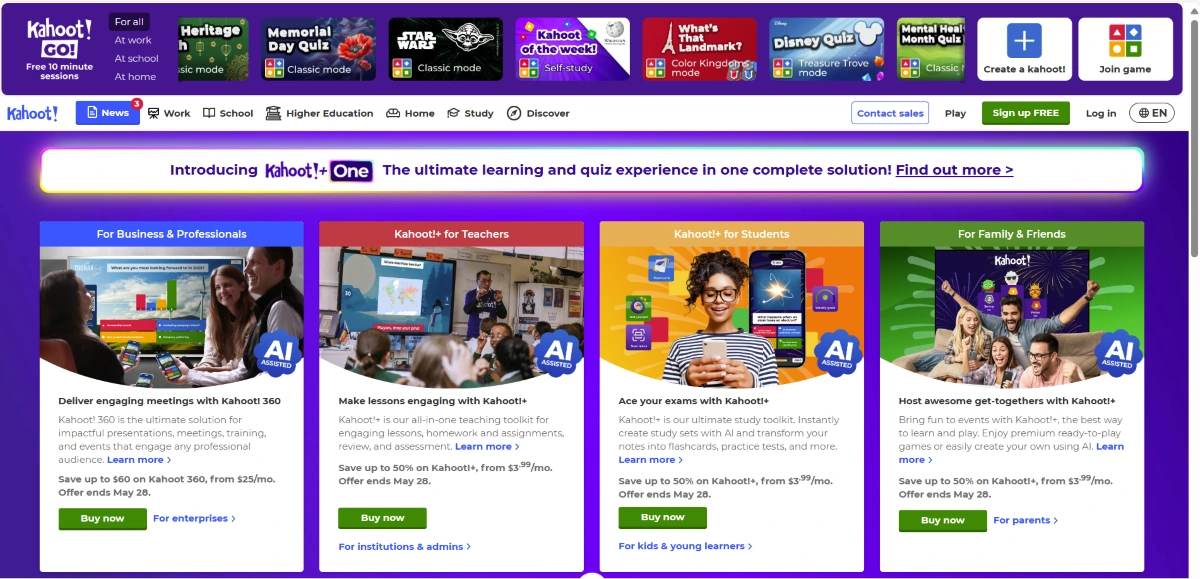
Kahoot Reviews and Testimonials
On review sites, Kahoot generally earns high marks. G2 rates it about 4.6 out of 5 stars (based on hundreds of reviews), and Capterra shows an average of 4.7/5 (from thousands of users). Teachers and business users praise Kahoot for making learning “fun” and engaging. For example, one G2 review calls it “an incredible platform to learn while having fun”. Users appreciate the competitive quiz format, easy setup, and lively interface. As one educator said, even young students can use Kahoot, and it makes lessons interactive.
Users often cite Kahoot’s restrictive pricing and feature limitations. For example, Kahoot’s own documentation confirms the Basic (free) plan allows only 10 players per session, meaning larger groups must upgrade. A reviewer on G2 similarly noted that the free plan “only allows 10 players per game” and requires payment for more . Summaries of user reviews on Capterra indicate that users find these limits frustrating and the tiered pricing confusing: one summary says users felt “misled by the free trial terms,” and another teacher mentioned the “cost of the different tools is not laid out in the beginning” when she discovered many features were locked behind paid plans. Overall, these comments suggest many users find Kahoot’s multiple subscription tiers unclear and restrictive.
Refund policies are another frequent complaint. Kahoot’s Help Center states that consumer subscriptions can be canceled within 14 days but that “dues already paid to us will not be returned” afterwards. In practice, reviewers report difficulty getting refunds outside this window. For instance, one G2 reviewer described Kahoot as having “no customer service” and a “hostage renewal process,” explaining how he paid $240 for a yearly plan, was charged again, and then was refused a refund when features weren’t available. Such accounts indicate that customers are rarely refunded once billed, reflecting Kahoot’s strict no-refund approach.
Importantly, Kahoot is a widely-used, legitimate platform. It’s a publicly traded company (ticker KAHOT on Oslo Exchange) with millions of users worldwide. Its official sites and security checks indicate Kahoot (and its player site kahoot.it) are “legit and safe” to use. In short, Kahoot has strong social proof and a global user base, even as users note both its strengths and pain points in feedback.
Kahoot Pricing
Kahoot offers both free and paid plans. The **Basic** plan is free for teachers and learners, but it limits sessions to 10 players and has only core features. Paid student/individual plans (Kahoot!+ Study) add more features: for example, the **Bronze+ AccessPass** plan is $3.99 per month (billed $48/year) and **Silver+ AccessPass** is $7.99/month ($96/year). (Higher tiers like **Gold** and **One** offer more games and players at $12.99–$24.99 per month.)

For schools and businesses, Kahoot 360 plans start around **$10 per host per month** and go up to $49 or higher for advanced analytics and large-scale sessions. There is also a one-time **Kahoot! 360 Event Pass** (about $250) for single events. In general, reviewers find the free version very limited, and moving beyond 10–20 players requires a paid tier. As one user put it, many advanced tools “are not laid out in the beginning,” leading to surprise upgrade prompts later.
Kahoot does offer free trials on select plans (often 7 days) if you see a “Start free trial” button when signing up. Their refund policy states that consumers can cancel within 14 days for a refund on feature subscriptions, but content purchases (like AccessPass content) are non-refundable. Paid months or years already billed are generally not refunded. In summary: the Basic version is free, but advanced features and large game sessions cost extra. Many users recommend reviewing the features carefully, as Kahoot’s pricing structure can seem complex
Kahoot Alternatives
There are several other platforms for quizzing and online learning. Here are a few to consider, including My Engineering Buddy (MEB) which offers tutoring:
My Engineering Buddy

My Engineering Buddy is an online tutoring service (covering math, science, engineering, etc.) rather than a quiz game. It offers **1:1 live help**, homework support, and test prep for college and advanced courses. MEB highlights that it uses “only the top tutors” and provides “high-quality services” to help students earn top grades According to its site, MEB has a 4.8/5 rating (285 reviews) with 97% of students recommending the service. Tutor quality is its focus, but pricing details are not publicly listed (likely competitive plans or pay-per-session). Ease of use depends on scheduling a session online. Reviewers generally praise MEB for personalized attention, which Kahoot (a self-play quiz tool) does not provide.
Quizizz
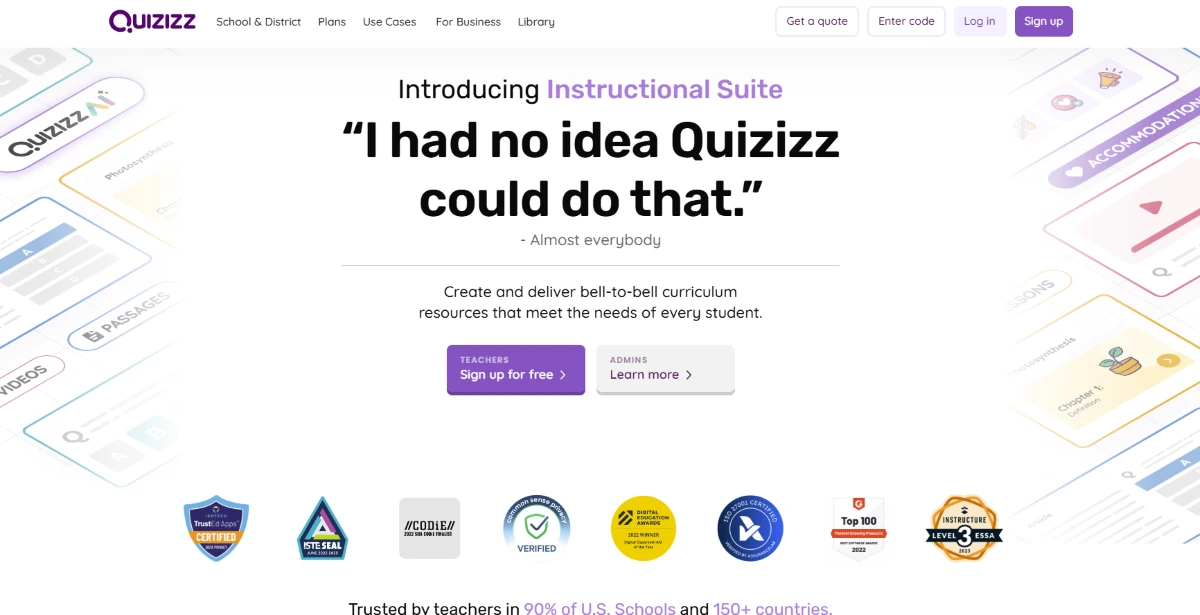
Quizizz is a quiz platform very similar to Kahoot, used by teachers and students. It has a **free Starter plan** (up to 100 players per game) and paid “Super” plans for larger groups or districts. The interface is user-friendly like Kahoot’s. Quizizz also allows assigning games as homework. There is no personal tutor service – it’s just quizzes – but it’s often free or low-cost for school use. Many educators find Quizizz’s free tier more generous than Kahoot’s (up to 100 players vs. 10).
Quizlet
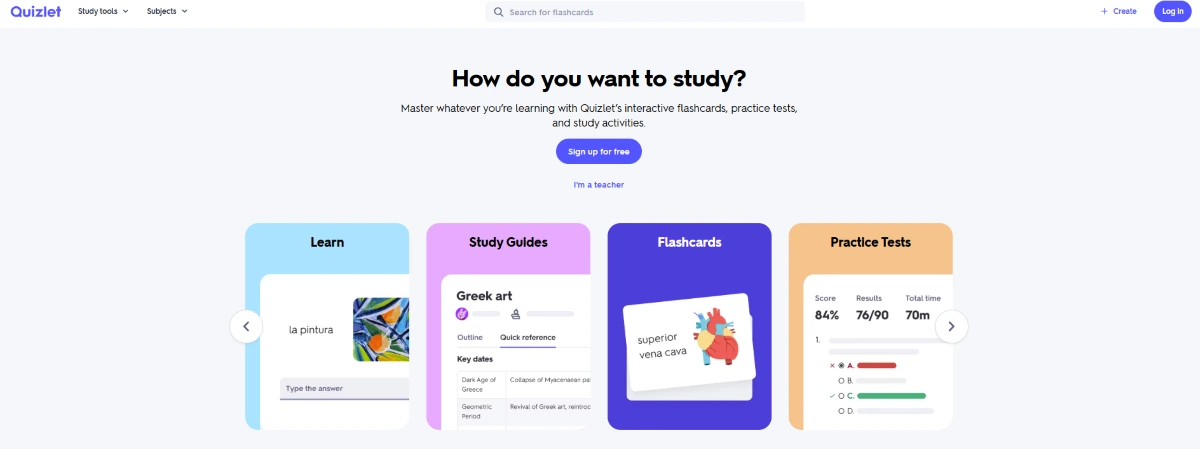
Quizlet is an online learning tool focused on flashcards and practice tests. Users can study with free flashcard sets or games and create custom decks. A basic Quizlet account is free (with ads), while **Quizlet Plus** (about $3–4/month for students) adds features like offline study, advanced modes, and auto-grading. Like Kahoot, Quizlet has a large library of content, but it is self-paced and not live-hosted. Ease of use is high, and it covers virtually all subjects. For interactive group games, Quizlet offers “Quizlet Live” in classrooms, but again it’s not one-to-one tutoring.
Khan Academy
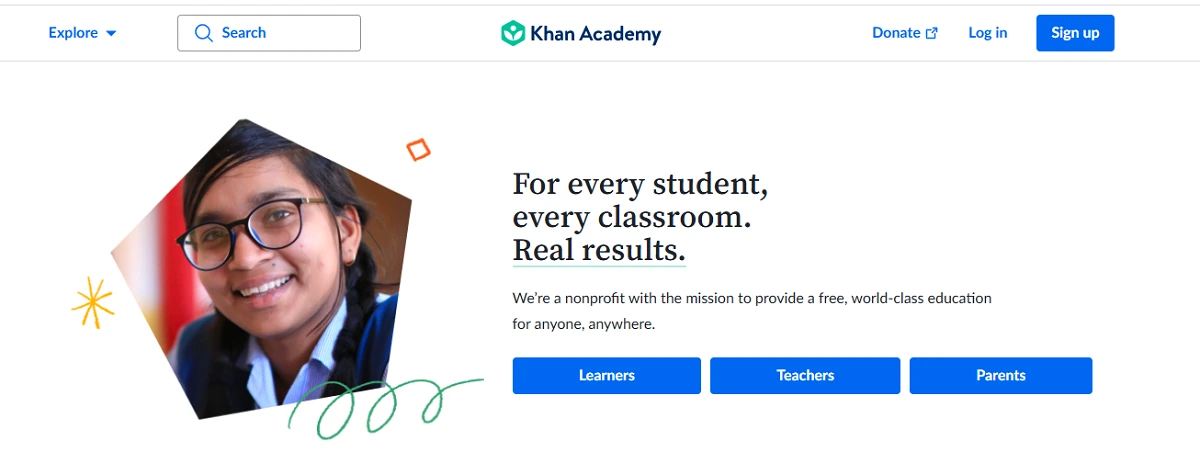
Khan Academy is a nonprofit offering completely **free** lessons, videos, and exercises on nearly every school subject. It covers math, science, humanities, test prep, and more, with practice problems and instant feedback. There’s no live tutor and no cost at all. Its content is very high quality, though it’s not gamified – learning is done via videos and exercises. Students who need structured lessons and practice (at no cost) often use Khan Academy, but it lacks Kahoot’s real-time competition features and MEB’s personalized tutoring.
Wooclap
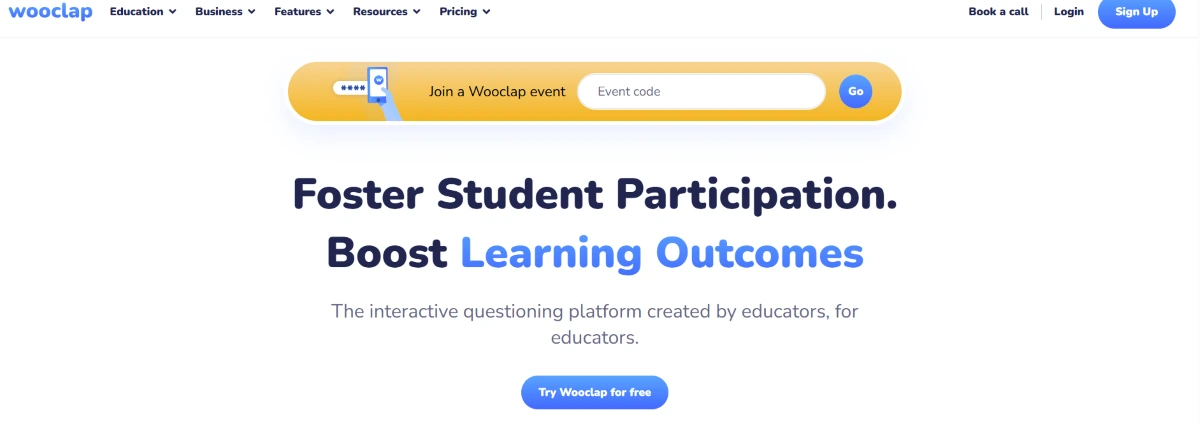
Wooclap is an alternative polling/quiz platform geared toward education and corporate settings. It lets presenters engage an audience with polls, quizzes, word clouds, etc. Importantly, Wooclap’s free plan allows up to *1000 participants*, making it more scalable for large groups. It’s less game-like than Kahoot (no avatars or music), but has richer question types and integrates with presentation tools. Wooclap emphasizes data insights for educators. Pricing is tiered (free starter, paid EDU/business plans) and generally straightforward. Unlike MEB, it still lacks one-on-one tutoring, but it’s a powerful Kahoot alternative for interactive sessions in both schools and businesses
How It Works
Student Experience
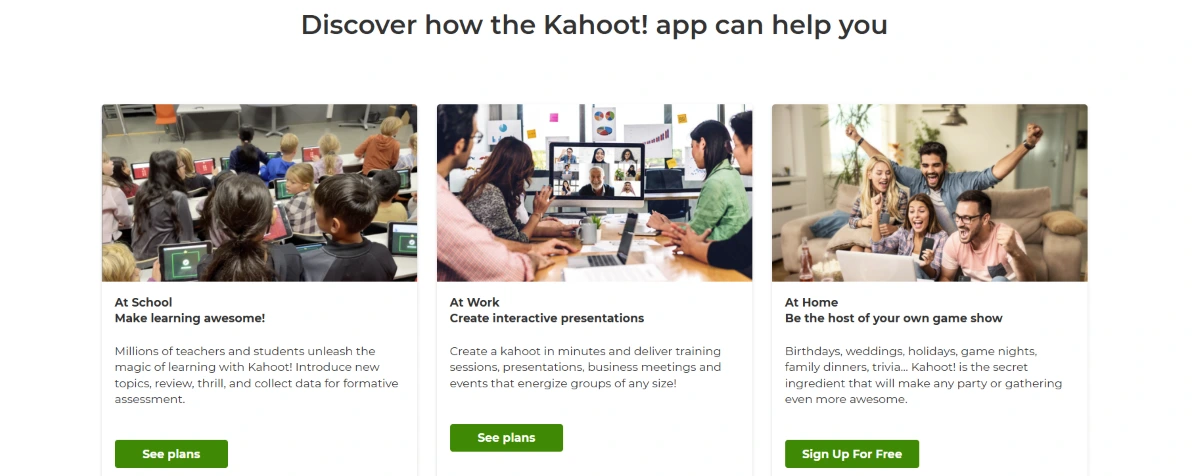
From the student side, Kahoot is simple to join. Students just open the Kahoot mobile app or kahoot.it on a web browser, enter the game PIN code given by the host, and they are in the quiz. No Kahoot account or subscription is needed for players. During the live game, each question appears on the shared screen, and students answer on their device. Kahoot shows a countdown and a running leaderboard, so students see how they rank in real time. After the game, players can view their score and performance report. Kahoot also supports **asynchronous play**: teachers can assign a “challenge” (homework) for students to complete later in the app, or students can play self-study quizzes using Kahoot’s apps
Tutor/Teacher Workflow
For teachers or tutors, Kahoot provides a web-based quiz editor and an account dashboard. Instructors log in, create a new kahoot by typing questions and multiple-choice answers, and can add images or videos. Kahoot even offers a huge question bank – it claims “half a billion” community questions – so teachers can pick from existing questions to speed up quiz . Once the kahoot is built, the teacher hosts it live by clicking “Play.” A unique game PIN appears on the shared screen (or virtual meeting), which students use to join. The teacher controls the pace of questions during the live session. Kahoot also allows scheduling kahoots as self-paced challenges that students finish on their own devices. After a session ends, teachers can download detailed reports showing each student’s answers and scores.
FAQs
Do students need an account or subscription to play Kahoot?
No. Students can join and play any Kahoot without creating an account or paying. Players simply open kahoot.it (or the app) and enter the game PIN provided by the host. The host (teacher) must be logged in and have the appropriate plan, but players themselves can play for free.
Can Kahoot replace personal tutoring like My Engineering Buddy?
No. Kahoot is a quiz-game platform for classrooms or groups, not a one-on-one tutoring service. It is designed for live or self-paced group quizzes and does not provide individualized teaching. In contrast, My Engineering Buddy offers 1:1 live tutoring where a student works directly with an expert tutor. MEB focuses on personal attention and personalized problem-solving, whereas Kahoot is self-driven gamified practice. Families needing direct homework help or concept explanation would choose MEB or similar tutoring over Kahoot.
What are the costs to use Kahoot?
Kahoot’s basic version is free, which includes core quiz tools for up to 10 players per game. Paid plans offer more features and larger sessions. For example, student plans start at about $3.99/month for Bronze, $7.99 for Silver, etc. School and business plans start around $10 per host per month (annual billing) and go higher for advanced packages, Teachers and reviewers note that many premium features (like more question types, higher player limits, detailed reports) require a paid subscription. Kahoot occasionally offers 7-day free trials on select plans. There is no fee for players to join games.
Is Kahoot a legitimate educational tool?
Yes. Kahoot! is widely used in schools and companies around the world. It is a publicly traded company with millions of users in over 200 countries. Trust checks rate kahoot.it (the student site) as “legit and safe” Its platforms and apps follow standard data policies for education. While no program is perfect, Kahoot is generally considered credible and effective for making learning interactive, as reflected by its high ratings on review sites.
Can Kahoot be used for any subject or language?
Yes. Kahoot quizzes can be created on any topic or subject area, from math and science to history or language learning. You can write questions and answers in any language to suit the class. The interface itself is available in multiple languages. Many teachers use Kahoot for multi-lingual or international classes because the content is completely customizable
What support is available and how do Kahoot’s policies work?
Kahoot’s customer support is available on weekdays (9 AM–5 PM CET) via its help center. They generally respond to inquiries within about one business day. There is a searchable knowledge base and even a chatbot for instant answers. In terms of policies, Kahoot lets consumers cancel a paid plan within 14 days for a full refund, but after that no further refunds are given. Lessons or content already purchased (like bundle content) are non-refundable. My Engineering Buddy promotes 24/7 tutor access (so help is available any hour), and while their exact refund policy isn’t public, most tutoring services allow rescheduling or have satisfaction guarantees.
Kahoot Company Information
Kahoot! was founded in 2012 and launched its platform in 2013 by three NTNU (Norway) graduates: Morten Versvik, Johan Brand, and Jamie Brooke. The company is headquartered in Oslo, Norway. Its mission, as stated by the founders, is to “make learning awesome” by turning lessons into game-like experiences. Kahoot’s vision is to build a leading global learning platform. In pursuit of this, the Kahoot! Group has acquired and built several educational apps (e.g. DragonBox math games, Poio for reading, Drops for vocabulary, Actimo employee engagement)
Today Kahoot serves a huge user base: about 300 million participant sessions were played in the last year, by roughly 30 million active accounts, in over 200 countries. It boasts that 97% of Fortune 500 companies have used Kahoot in corporate training or meetings. Its platform supports K–12 education, higher ed, and business trainings. Kahoot’s services include live game quizzes, surveys, polls, discussions, and self-study features. Key features include multiple question types (multiple-choice, true/false, puzzles, puzzles, polls, word clouds), premade themes and GIF libraries, and a massive question bank. The company has roughly 500+ employees worldwide and its products are localized for many markets (including languages and region-specific content). Kahoot is publicly traded (KAHOT on Oslo Stock Exchange) and generates revenue through its subscription plans and enterprise licensing.
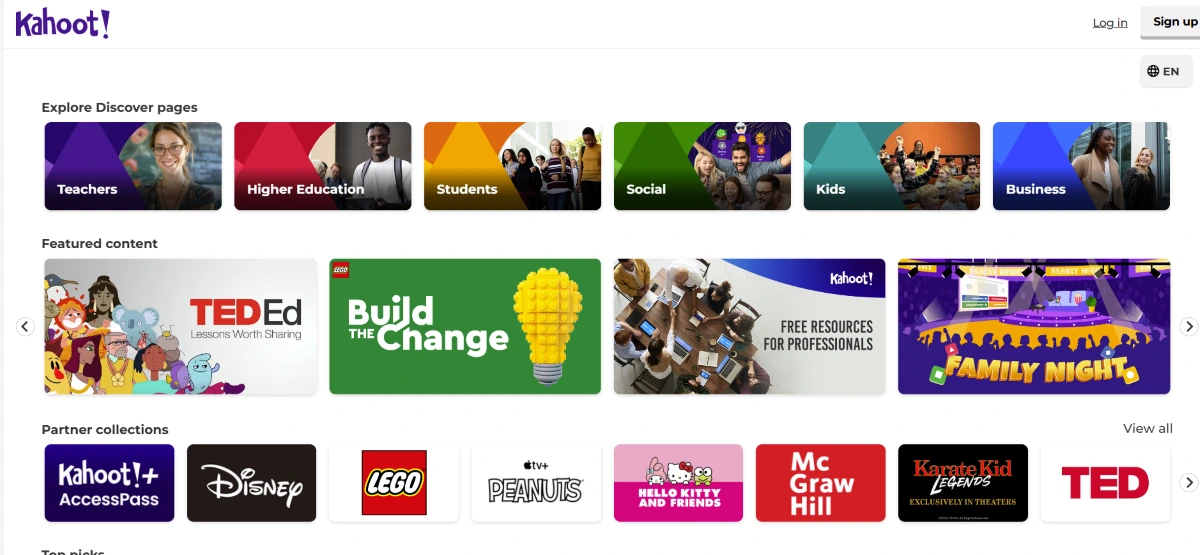
USP of Kahoot
- Gamified learning: Kahoot turns quizzes into games, making lessons “fun” and competitive. The game-show style (points, timers, music) motivates students and boosts engagement.
- Large question library: Users benefit from a vast community-driven question bank. Kahoot’s editor lets teachers pull from “half a billion” existing questions to create quizzes faster.
- Multiple game modes: It offers different quiz formats (quizzes, true/false, polls, word clouds, jumbles) to add variety. Students can also create their own Kahoots for study.
- Custom characters and media: Students can pick avatars and Kahoot supports images, GIFs, emojis, and music in games, creating a lively experience.
- Easy interface: Reviewers consistently note Kahoot’s simple, colorful UI is intuitive for any age. Both teachers and students find it quick to learn (no prior training needed).
Drawbacks of Kahoot
- Limited free plan: Only 10 players at once in the basic tier means most classes must upgrade. Many users say the free version is too restricted for larger groups.
- Complex pricing: The tiered plans (Study, School, 360) can be confusing. One reviewer called Kahoot’s pricing “complex,” and others have felt important features were hidden behind higher paywalls.
- Cost vs features: Some users say the basic paid plans don’t offer enough new features for the price. For example, a lecturer noted the annual fee felt high compared to what Kahoot provides.
- Cancellation and refunds: There is no prorated refund once past the 14-day trial. Users warn that if you miss the 14-day window, “you’re charged for the full year” with no cancellation option.
- Shallow assessment: Kahoot is great for quick quizzes, but it “lacks pedagogical variety” for deeper learning. It doesn’t support open discussion or one-on-one feedback. The format is more suited to rapid drills and contests than thorough concept mastery.
- Connectivity issues: Occasionally players report glitches or poor internet can disrupt a game. Also, teacher controls (like nickname filters) are basic, which can be problematic in some settings.
Comparison with My Engineering Buddy
Where Kahoot focuses on group quizzes, My Engineering Buddy excels in personalized tutoring. MEB assigns a real tutor to each student and offers 1-on-1 lessons, homework help, lab write-ups, and test prep. Many customers praise MEB’s tutor quality, saying its “top tutors” help students get “top grades”. In effect, Kahoot is a DIY quiz game (no live help), whereas MEB is a guided learning service. For example, a student struggling with calculus might use Kahoot for practice questions, but would rely on MEB to walk through problem-solving step by step. In testimonials, MEB students highlight the targeted support (e.g. “My Engineering Buddy helped me ace my engineering projects”) – something you won’t get from Kahoot. In short, Kahoot is great for engagement and practice rounds, but for in-depth coaching on difficult topics, MEB is a stronger option. (It’s telling that MEB boasts a 4.8/5 user rating and 97% recommendation rate.
Customer Support and Policies
Kahoot’s customer support is primarily online. Their help desk is available Monday–Friday (9 AM–5 PM CET) and typically replies within one business day. They offer a searchable knowledge base and even a chatbot for quick questions. Policy-wise, consumers can cancel a paid subscription within 14 days for a refund, after which no refunds are given. Subscription cancellations take effect at the end of the billing cycle. In contrast, My Engineering Buddy emphasizes 24/7 tutor availability (less reliance on office hours). While MEB’s refund policy isn’t public, tutoring services usually allow rescheduling and put customer satisfaction first. Overall, Kahoot provides decent tech support and clear refund terms (which some users find strict), whereas MEB advertises more flexible, on-demand help by live tutors.
Global Reach and Localization
Kahoot is truly global: it’s used in over 200 countries and supports any language. Teachers can write questions and answers in any language they choose. Kahoot’s interface and content have been translated for many markets. This broad reach makes it suitable for international classrooms. My Engineering Buddy, meanwhile, primarily targets English-speaking markets (e.g. US, UK, Canada, Australia and parts of the Gulf). Its sessions appear to be conducted in English with Western curricula. Kahoot has explicit localization (multilingual UI and content), whereas MEB seems to focus on English-medium instruction. Both platforms are accessible online worldwide, but Kahoot’s built-in language support gives it an edge in diverse settings.
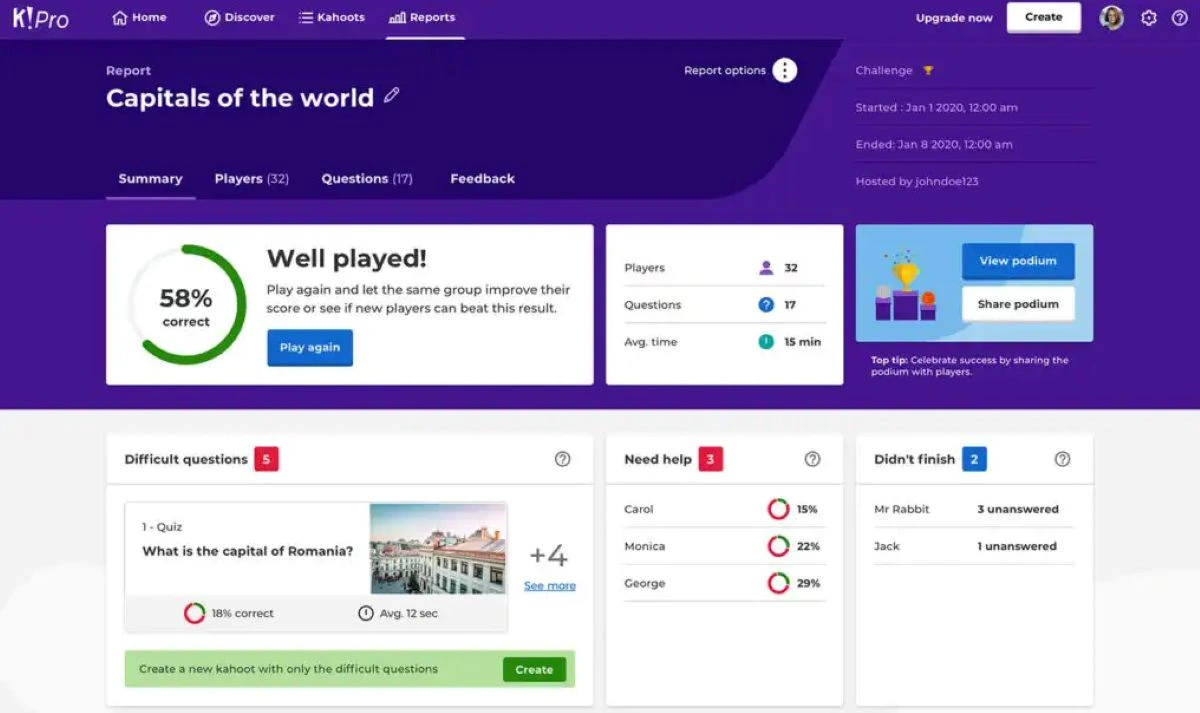
Kahoot’s Future Plans
Kahoot continues to invest in new technology and markets. A big focus for 2025 is AI-powered content creation. Kahoot already offers an “AI quiz generator” – teachers can input a topic, PDF, URL or even scanned handwritten notes, and Kahoot will instantly generate a quiz. Later this year, Kahoot will integrate with Microsoft’s new Copilot+ AI (Project Spark) to let educators automatically transform their lesson plans into Kahoot quizzes. This means content from trusted sources or teacher documents can become interactive kahoots with minimal effort. Early user feedback calls these tools “game-changers” for saving time in lesson prep. On the product side, Kahoot has also expanded beyond quizzes: for instance, in 2025 it launched **Kahoot! Energize**, a toolkit that integrates quizzes and polls directly into business presentations, showing growth in corporate training. Overall, Kahoot is moving toward more AI features, deeper data analytics, and wider enterprise offerings. We can expect more collaboration with big tech (like Microsoft) and new creative tools to “make learning even more awesome,” as their leadership puts it.
Conclusion
In summary, Kahoot! is an engaging, well-established game-based learning tool. Its strengths are clear: it makes lessons fun and competitive, it’s easy to set up, and it works at almost any scale with the right plan. However, users note its limitations: the free plan is very limited, the paid tiers can be confusing or pricey, and it is best for quick quizzes rather than deep tutoring. For students who need deeper one-on-one help, tutoring sites like My Engineering Buddy are strong alternatives, as they offer live expert assistance (with high user ratings). Kahoot remains popular for practice and engagement, but families looking for dedicated tutoring or homework help may consider MEB or similar services. Weighing these factors should help students and parents choose the right learning platform for 2025 and beyond.
Sources: Official Kahoot blog and help pages, review sites (G2, Capterra, Wooclap analysis), user reviews, and Kahoot press materials:contentReference[oaicite:102]{index=102}:contentReference[oaicite:103]{index=103}:contentReference[oaicite:104]{index=104}:contentReference[oaicite:105]{index=105}:contentReference[oaicite:106]{index=106}:contentReference[oaicite:107]{index=107}.

